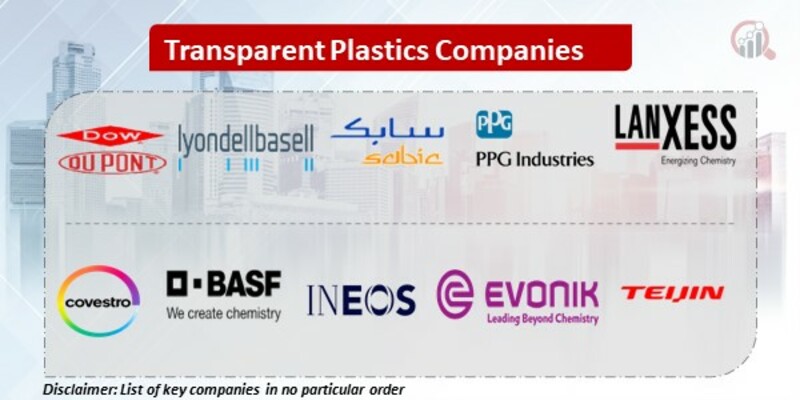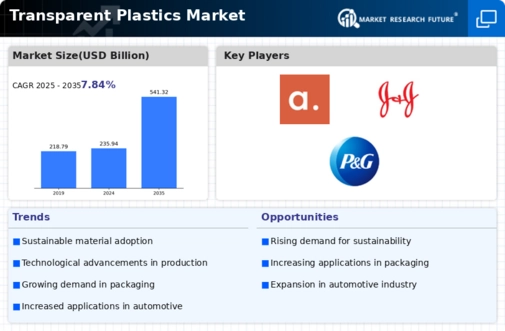Top Industry Leaders in the Transparent Plastics Market
 Transparent plastics, with their crystalline gleam and endless versatility, have carved a prominent niche in the global marketplace. From packaging our food to shielding our gadgets, these materials permeate various aspects of our lives. But navigating the competitive landscape of this dynamic market requires dissecting the strategies employed by key players, the factors influencing market share, the whispers of recent developments, and the industry's overall pulse.
Transparent plastics, with their crystalline gleam and endless versatility, have carved a prominent niche in the global marketplace. From packaging our food to shielding our gadgets, these materials permeate various aspects of our lives. But navigating the competitive landscape of this dynamic market requires dissecting the strategies employed by key players, the factors influencing market share, the whispers of recent developments, and the industry's overall pulse.
Strategies for a Shining Market Share:
-
Product Diversification: Leading players like SABIC, Evonik, and Mitsubishi Chemical are going beyond traditional offerings (PET, Acrylic) to cater to niche applications. This includes high-performance grades for automotive and medical uses, ensuring a foothold in lucrative segments.
-
Geographical Expansion: Asia-Pacific, with its booming economies and rising disposable incomes, is a magnet for market expansion. Companies are establishing local production facilities, forging regional partnerships, and tailoring product offerings to suit specific needs, solidifying their presence in this high-growth zone.
-
Technological Innovation: Continuous research and development are crucial for staying ahead. Companies like Eastman Chemical and Covestro are investing in green technologies for transparent plastics production, aiming to reduce environmental impact and capitalize on sustainability concerns.
-
Vertical Integration: Some players are integrating upstream (monomer production) and downstream (finished product manufacturing) activities. This enhances control over supply chains, optimizes costs, and provides a competitive edge.
-
M&A Activity: Mergers and acquisitions play a role in market consolidation. For instance, ExxonMobil's acquisition of SABIC's chemical assets in 2022 strengthened its position in the transparent plastics space.
Factors Shaping the Market's Transparency:
-
Demand Drivers: The diverse applications of transparent plastics, from packaging and construction to electronics and healthcare, drive demand. Growing populations, urbanization, and rising consumer spending in developing economies further fuel this growth.
-
Raw Material Fluctuations: Prices of key raw materials like naphtha and propylene are subject to fluctuations due to energy costs and geopolitical factors. These fluctuations can impact production costs and profitability for market players.
-
Sustainability Concerns: Environmental consciousness is driving the demand for recyclable and biodegradable transparent plastics. Governments are also implementing regulations to curb plastic waste, influencing material choices and production processes.
-
Substitute Threats: While transparent plastics boast unique properties, competition from alternative materials like glass and bio-based polymers can impact market share in certain applications.
Key Players
Some of the manufacturers operating in the Transparent Plastics Market are DowDuPont (U.S.), LyondellBasell Industries Holdings B.V. (Netherlands), SABIC (Saudi Arabia), Covestro AG (Germany), BASF SE (Germany), INEOS (U.K), PPG Industries, Inc. (U.S.), Evonik Industries (Germany), LANXESS (Germany), TEIJIN LIMITED (Japan), LG Chem (South Korea), Denka Company Limited (Japan), Trinseo (U.S.), Asahi Kasei Corporation (Japan), and Eastman Chemical Company (U.S).
Recent Developments:
-
October 2023: SABIC partners with a leading recycling technology company to develop and implement advanced recycling systems for post-consumer transparent plastics, promoting a circular economy in the industry. -
September 2023: Evonik unveils a new bio-based acrylic resin derived from plant oils, offering a sustainable alternative to traditional petroleum-based options. -
August 2023: Dow Chemical faces lawsuits from environmental groups challenging its production processes for certain transparent plastics, highlighting the legal challenges of traditional methods. -
July 2023: A consortium of universities and industry players launch a collaborative research initiative to develop next-generation transparent plastics with superior performance and recyclability.

